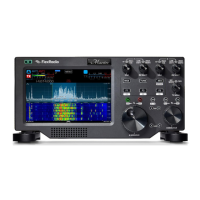FLEX-6000 Signature Series – Maestro User Guide
Copyright 2024 FlexRadio, Inc. All Rights Reserved. | Page 64
14 HOW TO CONFIGURE NOISE MITIGATION
The FLEX-6000 Series radios have several digital signal processing functions that enhance reception
in noisy environments.
14.1 AGC THRESHOLD
Automatic Gain Control (AGC) is a feature that automatically adjusts the Slice Receiver’s audio gain
(volume) based on the strength of signals in the receiver’s passband filter. The goal of AGC is to
amplify weak signals and attenuate strong signals so that they all lie within a comfortable listening
range.
The receiver Automatic Gain Control Threshold (AGC-T) can be adjusted for optimum performance
in noisy or quiet environments. The AGC-T sets the maximum gain applied under any
circumstances. Since the noise floor is relatively constant on a given band at a given time, the AGC
can be adjusted using the threshold control so that the AGC never applies gain to noise, but it will
apply gain to signals just out of the noise. In doing so, the AGC can reduce the level of noise you
hear, and help signals pop out of the noise.
The AGC system is a dual-track system, meaning that it can track both slow and fast increases in
signal strength, making appropriate gain correction decisions in the presence of each. The speed of
the AGC (FAST, MED, SLOW) determines how quickly or slowly the AGC recovers after attenuating a
strong signal. You can easily hear this by tuning to a CW signal and going through the three
settings. On FAST with a strong signal, you can hear the gain pump up and down while on SLOW it
recovers after a longer pause once the signal stops. When the signal stops, you will hear the noise
floor increase as the gain returns.
How to Set AGC for Different Operating Conditions
If you are listening to a loud voice signal, AGC SLOW will resist increasing the gain between syllables
and therefore reject most of the noise which is at a level far below the signal. FAST and MED
provide faster levels of recovery for situations when you want the system to closely follow the
dominant signal in the passband. Any time you have a very strong signal that causes the gain in the
AGC to be reduced, you could experience a loss of gain to a weak signal you are listening to. The
filter passband edges, which are continuously adjustable, and TNFs can be used to eliminate signals
that might interfere with AGC operation.
The operator might prefer to use SLOW settings when rag chewing in a high signal-to-noise
environment where there isn't much QRN and the noise floor is stable. This keeps the gain at more
of a constant level that is less distracting. If the operator is trying to pull a weak CW signal out of
the noise, they may prefer to use FAST mode to quickly ensure that the long-term average of the
noise floor doesn't overcome the signal and prevent it from being heard. MEDium is a reasonable
compromise.
When AGC is set to OFF, a fixed amount of gain determined by the AGC-T setting will be applied to
both fast and slow signals regardless of their level. The more you increase the AGC-T, the more
gain is applied and the louder the signal and noise will be. The benefits of increasing SNR with AGC
are lost in this mode. Another disadvantage of turning AGC off is that the operator must adjust the
'RF Gain manually to avoid distortion due to overload by strong signals.

